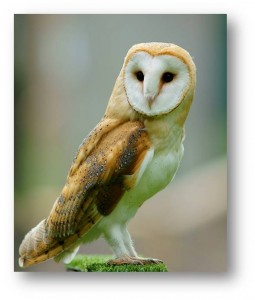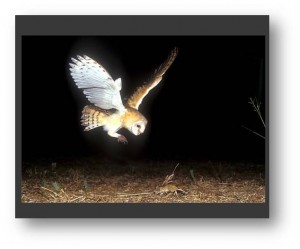
Picture 1: The Barn Owl, Tyto Alba
The Barn Owl (scientific name Tyto alba) is not only one of the most widely distributed of owls, but of all land birds. It is a highly adaptable bird, as seen in the versatility of both its food and habitat selections. And yes, the name is true; the Barn Owl is often found in rural areas nesting within barns.
The most striking feature of the Barn Owl is its almost pure white, round face, off-set by its coal-black eyes. They also have grey and tawny coloration throughout. There is slight sexual dimorphism, in that the males are usually whiter in color and smaller in size than the females. They are also equipped with the usual owl fixings that make it such an effective hunter, namely superb eye-sight, a razor-sharp beak and talons, special feathers for silent flight, and lopsided ears that allow them to pinpoint the origins of the softest of sounds.

Picture 2: A threatening display
Barn Owls are typically solitary birds, but they do sometimes live in pairs. They exhibit aggressive behaviors even as owlets, who often are seen pouncing at inanimate objects. They will defend their nests from intruders, chasing them out and attacking with claws. Barn Owls have two threatening displays: one has the owl with wings fully spread, the head held low and swaying back and forth (Picture 2) and the other has the owl with wings drooped and its body swaying side to side as it shifts from foot to foot and shakes its head. Both of these displays are accompanied with hissing.
Although these owls are generally monogamous, there have been a few reports of polygyny – where a male mates with more than one female. They will also find a new mate should their life-long partner die. Courtship begins with the male choosing a nesting site and using calls to attract females to it. The male will then bring food to the female, followed by both sexes engaging in copulatory displays by crouching in front of one another.
For their nests, Barn Owls will often use existing cavities in really, almost anywhere: trees, cliffs, rocky outcrops (Picture 3), caves, and buildings. The only known instance of not using existing cavities is in Colorado and New Mexico, where the owls will dig nest burrows into the soft soils of arroyo walls. Interestingly, Barn Owls will select a nest site based on the type of site in which they were raised.
Once the eggs are hatched, the female will spend all of her time in the nest brooding the young. The male will go out to hunt and bring food back to the nest, and the female will take the prey item and feed it to the hatchlings. She will tear it into small pieces and feed it to the young, beak to beak.
Barn Owls live in most of the 48 mainland U.S. states (Picture 4,) as well as Central America and much of South America, settling primarily in open habitats such as grasslands, deserts, marshes, and agricultural fields. They can also be found in and around metropolitan areas. Although young Barn Owls may disperse hundreds of miles from their original hatching site, they are non-migratory birds.
Barn Owls are deadly and efficient nocturnal hunters, using their excellent eye-sight and hearing to locate their prey in the dark. They will fly and ambush their prey, being able to close in silently because of their special flight feathers, and grab it with their talons (Picture 5.) Most times it will be swallowed whole, and as all owls can do, the fur and bones will be regurgitated in small, compact masses known as “pellets.” Prey items for the Barn Owl include small mammals such as rodents, shrews, and bats, and occasionally small birds such as starlings.
There are three areas in which Barn Owls are to be further researched. The first addresses its elusive nature and urges that new techniques be developed so that population counts of this owl can be accurate. The second is the bird’s role in rodent control; although it was thought that attracting nesting Barn Owls to certain areas would control populations of pocket gophers in California, the results are still unclear and require further research. The third calls for the requirement of long-term studies on these owls in tropical and subtropical areas to compare with the extensive research that was already done in north temperate regions.
References:
http://www.allaboutbirds.org/guide/Barn_Owl/id (Cornell Lab of Ornithology)
http://bna.birds.cornell.edu/bna/species/001/articles/characteristics (Birds of North America Online)
By: Ellena Nador and Grace Bae




I saw a barn owl the other night at the bottom of our front door ramp. There was a big puddle from recent rain and it was standing in the puddle. It stood there and stared at me for a long time. At first I thought is was a weird looking kitten (my eyes aren’t great) but then it flew off and it was obvious it was an owl. I think it was swaying at me but I’m not sure. I like in a residential neighborhood near downtown Austin. It was really cool.